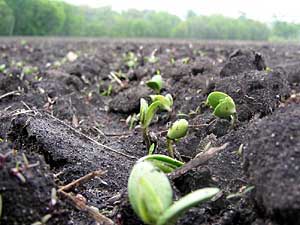|
Audio
Photos
Resources
|
June 20, 2005
Too much rain this month could result in significant crop damage in parts of Minnesota. Some top state agriculture officials plan to tour west central and northwest Minnesota next week to survey the damage.
Moorhead, Minn. — For some Minnesota farmers there's been enough rain to bring the promise of a bumper crop. But a few miles down the road too much rain might have crops struggling to stay alive.
Rainfall has been above normal for much of the state. In some areas, precipitation for June is already twice the seasonal average for the month.
In northwestern counties like Kittson and Roseau, many farmers were unable to plant this spring because fields were too wet.
Nathan Johnson of the University of Minnesota Extension Service says thousands of acres were not planted, and many of the crops that were planted are standing in waterlogged soil.
"The crops that are emerging -- the small grains and soybeans, especially the small grains -- are showing signs of yellowing because of this moisture stress," says Johnson. "And right now we need a real stretch of dry weather and wind to go with it, to bring this crop back around."
Weather conditions into early July might decide the fate of many acres of crops in northwest Minnesota, according to Johnson.
Dairy and beef farmers have abundant pasture and excellent hay crops because of the rain, but many are finding fields too wet to harvest the hay. If not harvested at the right time, hay quality deteriorates.
Wet conditions extend into west central Minnesota counties.
University of Minnesota crop specialist Doug Holen says crops are under severe stress from the saturated soil. There's also a bumper crop of weeds, and some farmers are weeks behind in applying herbicide.
"Weed control and competition the first four to six weeks is very important. Yields are being determined very early in most of these crops. So we can't afford to be to far behind in that," says Holen.
Some farmers tell Holen conditions have not been this wet in 40 years.
Farmers who haven't planted crops yet are faced with a dilemma. Jim Stordahl, University of Minnesota Extension agent in Polk County, says they can plant when the ground dries and hope the crop has time to mature, or they can take crop insurance payments which barely cover their expenses.
"In most cases it covers the land cost and maybe a little bit extra. It's usually not adequate to replace the crops," says Stordahl. "But planting and taking a chance on recovering some of that potential income, that's a huge roll of the dice. But some farmers are actually considering that."
In the northern part of the state, farmers are rapidly running out of time to plant or replant crops.
There are also areas with soggy farm fields in southeastern and southwestern Minnesota. Farmers there may be able to plant some crops into early July, and still get a decent crop in the fall.
Minnesota Farm Service Agency Director John Monson says he's planning to tour soggy parts of the state next week. He'll be gathering information for a possible disaster declaration request.
The wet conditions also cover much of eastern and north central North Dakota, and Gov. John Hoeven has ordered a statewide assessment of crop damage.




